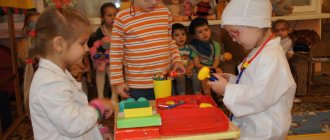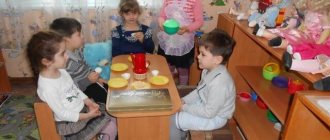Role-playing game "Theater" (preparatory group)
Role-playing game "Theater" (preparatory group)
Purpose of the game:
- teach children to distribute roles and play them to the end;
- demonstrate the ability to negotiate with each other;
- cultivate goodwill and form positive relationships between children during play;
- develop social and communication skills;
- clarify and generalize children’s knowledge about theater and theatrical professions; develop dialogical speech;
- expressiveness of the role;
- imagination and creativity.
Preparatory work: conversations with children about the theater, theater operators; view illustrations of our city’s theaters; reading works on the theater “The Magic World - Theater” by T. Grigoriev, “In the Theater” by A. Barto; a trip and viewing of a performance in a children's theater; games - shows based on fairy tales; watching the cartoon “Zayushkina Izba”; talking about what you saw.
Game attributes: signs: theater, ticket office, buffet, locker room, wardrobe; paraphernalia for the coffee game; paper and colored pencils; material for making flowers; paper wallets and coins; deceive; mobile phones (toys); bell.
Roles: actors, costume designer, make-up artist, decorator, bartender, cashier, controller, taxi driver.
Progress of the match: in the morning the announcement “Attention, attention! Tonight the performance “Zayushkina’s Hut” will take place. Director Tatyana Viktorovna is recruiting artists, costume designers, decorators, make-up artists, bartenders, and cashiers. I lead the discussion, observe the distribution of roles, if there are children who do not want to take part in the play, then I invite them to become spectators, but if everyone agrees to take part in the production, then we invite children from junior to middle age to become spectators. At the beginning of the conversation, I show and clarify the children’s knowledge about theater and theatrical professions. I would like to draw your attention to the fact that before the audience sees the performance, many people are involved in its pedagogical preparation: guys, do you know what theater is? And what is this for? Children: The theater is a place where different performances are shown for children and adults. Educator: do you know what theaters are? Children: Children's musical theater, Puppet theater, Shadow theater, Drama theater, Bolshoi theater, Animal theater Teacher: Guys, what do you think theaters are for? Children: give the elderly and adults the opportunity to spend free time and attend interesting performances; help people rejoice and receive a lot of positive emotions; see and learn something new and interesting; meet the actors and see their skills. Educator: how many of you know what is in the theater? Children: auditorium, buffet, wardrobe, stage, backstage. Educator: Now let's talk to you about each of the places you mentioned. Let's start with the wardrobe, what is a wardrobe and what is it for? (children's answers) That's right, guys, this is the place where the viewer first goes, there is also a saying: “The theater begins with crutches.” Educator: go to the buffet, what is it for? (Children's answers) Indeed, it is necessary that people can have a snack or eat something tasty, because sometimes it happens that some spectators come to the theater after the end of the working day. Educator: So you and I have arrived at the hall, what interesting things can we see there? (children's answers) Indeed, the auditorium is one of the most interesting places in the theater, because it is there that the artist goes on stage, as if communicating with the audience, conveying the character of the hero with his intonation, facial expressions, and gestures. Educator: This is one of the most mysterious places in the theater, what do you think? (children's answers) That's right, these are the wings, these are the rooms that help a person turn into the desired character. Educator: Do you know what professions people work in the theater? (children's answers) What do the actors do before the performance? (children's feedback) distribute the roles, try it. What do chests of drawers do, what is the name of the room in which they work? (children's answers) choose costumes, masks, wigs and all the necessary attributes that suit the roles, sew the costumes and iron them. What do makeup artists do? (children's answers) with the help of makeup and small additions help the artist become more like his character. What do charts do? (children's answers) we prepare a script, draw sketches of tickets. What do coffee pots do? (children's answers) build a showcase, buy goods - products. Do audiences need to prepare before visiting the theater? (children's answers) buy a ticket; prepare the dress; buy flowers as a gift for artists.
Then the children begin to act according to the chosen role, I move from one group to another.
1. Cafe - I will ask what products are sold in the cafe, where the goods will be placed, how buyers will find out the price, where the seller will put the money received for the purchase.
2 artists - I’ll ask how to arrange 2 screens - houses, so that you can see where whose house is (textiles), what decorations can be added to make it look more like a forest (trees), I’ll suggest creating a sketch of tickets (competition), if there are heroes, who need paraphernalia, I’ll ask the guys what they will make them from.
What else to read: Compiling a descriptive story based on a diagram on the topic “Dishes”
3 Chest of drawers and makeup artists: turn on if necessary.
4 proofs: what is the hare’s mood at the beginning of the fairy tale, how can it be conveyed in his voice? As the fox speaks, the intonation of the fox's voice changes at the beginning of the tale, and then. What words does everyone say when they meet a hare? Are the voices of a dog, a bear and a rooster different?
In the morning, the first part of the game takes place (fairy tale rehearsal, costume selection, selecting a ticket design (multiplying) - competition, house decoration, cafe decoration)
In the evening: while the performers are putting on their costumes, they are assisted by clients; artists decorate the stage; the collector sells tickets; spectators buy tickets and choose the attributes of a festive outfit, call a taxi and head to the theater; Ticket holders check their tickets, explain where to go and offer to buy a program (consisting of sketches that did not pass the competition), invite them to the bar, warning them that entry into the auditorium is prohibited after the third bell. In addition, spectators from other groups watch the performance, applaud and give flowers at the end. During the game, I pay attention to how the dialogues are structured (detailed, polite forms, the ability to listen to the partner’s speech to the end). If there are unused children, additional roles are selected: a taxi driver, a television cameraman or a correspondent interviewing artists.
At the end of the game, I summarize: did you like the role you chose? Do you think you managed to convey the character of your character? What role would you like to play next? I really liked the performance, all the characters were very bright and memorable. Each character knew his words and acted according to the text. The audience was very polite and well-mannered, they didn’t speak during the performance, they said magic words at the buffet table (hello, thank you, goodbye). All theater operators performed their duties with dignity. I want to come to your theater again. Thank you all!
Teacher of the first qualification category Tatyana Viktorovna Kozubnyak
Role-playing game in the senior group "Theater"
Summary of a role-playing game for the senior group of a kindergarten Description of the material: I bring to your attention an annotation for the role-playing game “Theater”. This game took place in the senior group. The children liked the game. Objectives: * consolidate children's ideas about cultural institutions, their social significance, children's knowledge of the theater, troupe, theater directors, show the collective nature of work in the theater; * teach children to act according to the role they take on, to develop expressive speech; * form a friendly attitude and moral and ethical standards of behavior in children. Preparatory work: * invite parents to the theater with their children; * conversation about the theaters of our city as cultural institutions; * examination of postcards from theaters in the city of Kemerovo; * conversation about the rules of behavior in the theater; * reading the fairy tale “Zhikharka” and narration by roles; * production of paraphernalia for the game: screen and its design, tickets, seat numbers, masks for actors, poster, money, cash register, “buffet” sign, sewing an apron and cap for the bartender. Subject-game environment. Equipment: * requirements for the performance - screen, stove, shovel, bench, table, wooden spoons, wooden cups, cast iron pot, ladle, costume elements; * details for the buffet table - buffet sign, cash register, money, products (cake, chocolate, juices, sweets), apron, garrison cap, doll plates (cups, teapots, saucers, tray), flowers; * cash register details – cash register window, calculator, money; * requirements for the controller – chairs, numbers. Game progress
Teacher: Children, what unusual did you see today when you joined the group? Children: Manifesto! Educator: Who can read what is written on it? (Children read) Educator: What do you think this poster is for? Children: To tell us that there will be a performance, and they came. Educator: What is the name of the institution where the performances are held? Children: Theater Teacher: What clothes do we wear to the theater and how should we behave there? Children: We go to the theater in elegant, well-combed clothes, speak quietly, politely, do not run, throw garbage into trash cans, etc. Educator: That's right. The theater is a cultural institution, and here you need to behave culturally. Do you want to do theater? Children: We want! Educator: What should I do to start playing? Children: distribution of teacher roles: do we remember who works with you in the theater? Children: controller. Educator: what tasks does the controller perform? Children: Places chairs in a row, hangs numbers, checks spectator tickets, helps them find their seats. Educator: who will be the controller? Please prepare your work area. Children: cashier. Educator: What are the responsibilities of a cashier? Children: the cashier sells tickets. Educator: who will be the cashier? Please prepare your work area. Who else works in the theater? Children: bartender. He puts the goods on the counter and sells them in between. Educator: who will take on the role of bartender? Please get to work. Children: stage operators also work there. They set the requirements. (The teacher chooses two boys) Educator: Without whom there can be no theater and why? Children: The performance is shown without actors. (Artists and pre-prepared children go behind the screen and put on masks.) Educator: And we will be spectators. What will we do in the game? Children: we buy tickets, sit down, during intermission we go to the buffet, buy food, clap our hands, give flowers to the teacher-artists: we clean up, fix our hair and go to the theater. Where are we going? Children: By car, by bus. (The teacher invites the children who board the bus to go to the stop. The driver and conductor take off their attributes, passengers take imaginary seats, the bus moves. The conductor announces: “Stop - theater”, passengers get off the bus, cross the theater.) Children play according to with their assigned roles. The teacher approaches the children, watches how they cope with their responsibilities, and helps if necessary. The first bell rings, the second, the third. The audience takes their seats. The game begins. The teacher reads the words of the author, the artists interpret their roles. The first action is over. The interval is announced. Spectators go to the buffet for food. Stage operators rearrange props. The controller checks the numbers on the chairs. (The teacher asks all the children to come closer to her) Educator: Children, do you like to play? Children: Yes! Educator: Do you think the cashier copes with his duties? Was she kind to you? What polite words did he say to you? (The teacher tells the children about each role. The children evaluate each role of the actors.) Teacher: Do you want the children to continue playing in the theater? Children: Yes! Educator: Then the game continues, taking into account all the wishes. The first bell rings, the second, the third. Spectators take their seats in the hall. The second act begins. The teacher reads the author's words. The artists perform. The buffet counter has been repaired, sweets are being placed in boxes, and flowers are being sold. The second campaign is over. The interval is announced. Spectators go to the buffet, buy sweets, flowers, straighten their hair. Stage operators rearrange props for the performance. The first bell rings, the second, the third. Spectators with flowers take their places and the third act begins. At the end of the show, the audience claps their hands, shouts “Bravo!”, throws flowers onto the stage or presents them to the artists. The artists bow and go backstage with flowers. (The teacher asks all the children to come closer to her) Teacher: Do you think our game was a success? Children: Yes! Educator: What did you like most? (The children say that they liked the game the most. The teacher summarizes the children’s statements and thanks everyone who played.)
What else to read: How to tell children about space: pictures, cartoons and descriptions
We recommend watching:
Role-playing game for older preschoolers Mod Atelier Role-playing game in the senior group of a kindergarten Summary of the role-playing game “Cafe” for the senior group of the kindergarten project. Development of role-playing games in the middle group of kindergarten
Similar articles:
Preschool role play
Games, songs, exercises for preschoolers “Igralochka”




